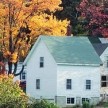How To Replace Door Sill Rot
Poor Flashing, Water Damage And Carpenter Ants Defeat Entry Door
A quick look at this entry door did not show anything unusual but a closer inspection revealed that the bottom of the door and sidelights had been spliced “quickly and poorly” prior to us. This article is about how to replace door sill rot.
Two Clues To Improper Flashing
Two notable clues that I saw was that the porch decking was to close to the inside floor height. A 7″ step into the house would have helped keep water and melting snow out. The second was there was a fairly new gutter above this door and no gutters anywhere else on the house.
The gutter was added after the repair to the door. Rain run off from the roof must have pelted this porch landing and door.
Part of this project was to remove this glass entryway. When we were removing the tile floor we discovered that water had leaked in and rotted out he floor sheathing and a few floor joists.
Remove The Door
We also discovered that this was the second repair to this area, this is when we realized that the door needed to be removed to repair the house sill and joists below.
Once the trim was removed we discovered carpenter ants had eaten into the door jamb, sidelights and surrounding framing.
Carpenter Ants Follow Water!
Carpenter ants are large (¼–1 in) ants and are indigenous to many parts of the world. They prefer dead, damp wood in which to build nests. They cut tunnels into the wood grain to provide passageways for movement from section to section of the nest. [see photo below – click to enlarge]
Sometimes their presence can be detected by the saw dust they leave behind.
The glass entry and door was removed. The door was for a 2×6 wall and this house had 2×4 walls.
A prior installer had padded out the wall thickness in the glass enclosure to hide the difference in jamb thicknesses. This door also had odd size side lites and a side lite modified and used as a transom above the door. The whole assembly had been cobbled together.
Now the floor and framing had to be repaired.
Worn out and damaged aluminum flashing had long since failed. Nail penetrations into the flashing allowed water to enter the house. It is imperative never to nail through flashing for this reason.
Rotted 2×4 sill plates, studs and exterior sheathing were found on either side of the door.
Door was thrown in trash and a new one ordered. The only problem was that the new door was 5 to 6 weeks away and we had a large opening in this house.
Where is the structural door header??????
The difference in height between the porch deck and the interior floor was only an inch or two.
Unfortunately this deficiency will have to be corrected someday when the porch is replaced.
Floor joists, sill and sub floor was replaced. Area flashed with rubber.
This is a non-bearing wall but it still has weight. We replaced the ant infested studs, added a structural header and boarded up the opening .
Tar paper sealed the outside to keep the area dry until the new door arrived.
Inside view.
New door arrives. Fine tuning to the framing and flashing.
A Simpson fir flat panel, 3-lite door with matching side lites is the new entry door of choice. Because of the low step we chose an aluminum sill and rot saver jamb option for the door.
Door installed
Installing vapor barrier, tar paper and rubber flashing around the door.
Unfortunately the transoms were larger than normal and the clapboards had to be removed and replaced which adds a significant amount of work and material to a door swap out.
The top of the clapboards terminates into a flat trim board and crown molding. We were able to splice new crown where the transom used to be.
A dental head PVC pediment detail and fluted column trim finishes off the door.
~ concord carpenter







